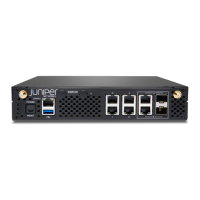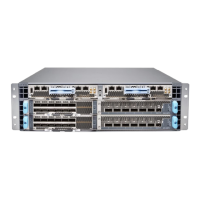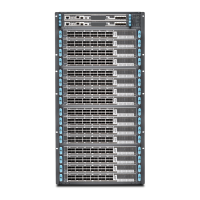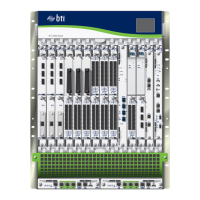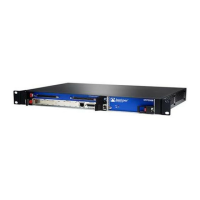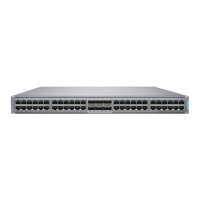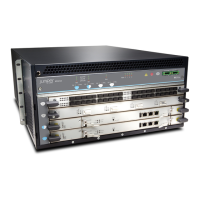by bridging them through a virtualized internal switch function in the host OS. The overall
architecture of virtio is shown in Figure 5 on page 9.
Figure 5: VNF Bridging with Virtio
Figure 5 on page 9 shows the inner structure of a server device with a single physical
NIC card running a host OS (the outer cover of the device is not shown). The host OS
contains the virtual switch or bridge implemented with virtio. Above the OS, several virtual
machines employ virtual NICs that communicate through virtio. There are multiple virtual
machines running, numbered 1 to N in the figure. The standard “dot dot dot” notation
indicates possible virtual machines and NICs not shown in the figure. The dotted lines
indicate possible data paths using virtio. Note that traffic entering or leaving the device
does so through the physical NIC and port.
Figure 5 on page 9 also shows traffic entering and leaving the device through the internal
bridge. Virtual Machine 1 links its virtualized internal NIC interface to the physical external
NIC interface. Virtual Machine 2 and Virtual Machine N link internal virtual NICs through
the internal bridge in the host OS. Note that these interface might have VLAN labels
associated with them, or internal interface names. Frames sent across this internal bridge
between VNFs never leave the device. Note the position of the bridge (and virtualized
switch function) in the host OS. Note the use of simple bridging in the device. These
bridges can be configured either with regular Linux commands or the use of CLI
configuration statements. Scripts can be used to automate the process.
Virtio is a virtualization standard for disk and network device drivers. Only the guest device
driver (the devices driver for the virtualized functions) needs to know that it is running in
a virtual environment. These drivers cooperate with the hypervisor and the virtual functions
get performance benefits in return for the added complication. Virtio is architecturally
similar to, but not the same as, Xen paravirtualized device drivers (drivers added to a
guest to make them faster when running on Xen). VMWare’s Guest Tools are also similar
to virtio.
Note that much of the traffic is concentrated on the host OS CPU—more explicitly, on
the virtualized internal bridges. Therefore, the host CPU must be able to perform
adequately as the device scales.
9Copyright © 2017, Juniper Networks, Inc.
Chapter 1: Architecture Overview
